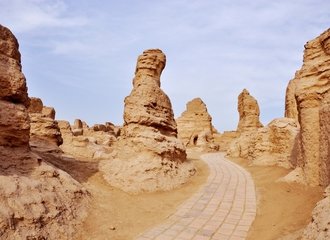Potala Palace Tibet
Brief Information on Potala Palace:
Potala Palace, regarded as the highest ancient palace in the world, stands on the Red Hill of the heart of Lhasa city, resembling a magnificent fortress in heaven. The palace is painted white and red, which means peace and stateliness in Tibetan cultures. Used to be the home of the Dalai Lamas, Potala Palace once was the religious and political center of Tibet, which makes it the best place to learn about the unique Tibetan Buddhism of the world. It is the magnificent building with the highest altitude in the world, which integrates palaces, castles, and monasteries, and is also the largest and most complete ancient palace complex in Tibet.
Named after a holy hill in South India, the Potala Palace is also a sacred place for those who are interested in the Tibetan cultures. It is not just a gift of the Tibetan King Songtsen Gampo to greet his bride, Princess Wen Cheng, in the Tang dynasty of China, but a gift to the people all over the world. Due to its magnificent architecture and rich cultures, the palace was listed as a World Heritage Site by UNESCO in 1994, and recently named one of the "New Seven Wonders of the World" by the television show Good Morning America and the newspaper USA Today.
The Potala Palace is magnificent in the world in terms of architecture, historical significance, and cultural relics. No one would deny that the gorgeous snow-capped mountains and the sacred lake are even more fascinating and memorable. The Jokhang Temple is the spiritual center for the Tibetans, but the Potala Palace represents the snow-covered plateau and the untraceable belief for travelers.

Best Photography Point
- Chakpori Hill (Yao Wang Shan) is located on the right side of the Potala Palace at an altitude of 3,725 meters. Chakpori Hill is close to the Potala Palace and is the best angle for shooting the Potala Palace, especially the mountainside.
- The lakeside of the artificial lake on the south side of the Potala Palace Square is the best place for shooting reflections.

The layout of Potala Palace
The Red Palace
The Potala Palace is composed of two parts, the Red Palace at the top middle and the White Palace as two wings. Painted deeply red and richly decorated with painting, jeweled work, carving and other ornaments, the palace was once the religious center to hold ceremonies. The highlights here include The Great West Hall, Dharma Cave, The Saint's Chapel, The Tomb of the Thirteenth Dalai Lama.
Regarded as the largest hall in the Potala Palace, the Great West Hall is famous for the beautiful murals painted on its inner walls, and most of them are some stories or Buddha in Tibetan Buddhism. The Dharma Cave and the Saint's Chapel are the only two remaining architectures of the 7th century which still well preserve the statues of Songtsen Gampo, Princess Wen Cheng, and Princess Bhrikuti. Located west of the Great West Hall, the Tombs of the Thirteenth Dalai Lama is the giant stupa that contains priceless jewels and one ton of solid gold. Elaborate murals in traditional styles of Tibetan culture depict many events of the life of the Thirteenth Dalai Lama during the early 20th century.
There are a total of 8 spirit pagodas in the Red Palace where the Dalai Lama ’s immortal bodies are stored, of which the Fifth Dalai Lama's spiritual pagoda is the largest. The statue of the Fifth Dalai Lama is the same size as the golden statue of Sakyamuni, sitting on an equal foot. This is a very rare design of a Buddha. It also represents the reputation and achievements of the Fifth Dalai Lama in Tibet.
The White Palace
Surrounding the Red Palace is the White Palace, which used to be the dwelling place of the former Dalai Lamas and the official buildings of Tibet local government. The color white of these palaces symbolizes the peace and quiet in Tibet. Located on the fourth floor, The Great East Hall is one of the most important halls in the White Palace, used to be the site for momentous religious and political events. The fifth and sixth floors are used as the living quarters and offices of regents while the seventh floor, the top one, is the living quarters of Dalai Lama consisting of two palaces named the East Chamber of Sunshine and the West Chamber of Sunshine due to the plentiful sunshine.

Useful Travel Tips:
- The admission of Potala Palace is 200 CNY/ Per person from May to October, and 100 CNY/Per Person from November to April.
- The opening time: From May 1st to October 31st, 09:00 am to 16:30 pm. From November 1st to April 30th, 09:00 am to 15:00 pm.
- The Potala Palace implements a pre-sale and limited-sale ticketing system, and the number of visitors per day is limited to 2,300. Especially in July and August every year, it is necessary to book entrance tickets in 7 days in advance.
- It is not allowed to bring water bottles, drinks, cosmetics, and other liquids, and it is also not allowed to bring knives, firearms (lighters, matches), etc. You need to leave them at the ticket office if you bring prohibited goods. You can take it back when you come out of the north gate after the sightseeing.
- There are Tibetan Buddhism taboos to follow during the sightseeing: not wearing a hat, not taking pictures (referring to entering the palace, you can take some "outside scenery" outside the palace), not stepping on the threshold, etc.
- All tourists are required to complete the visit within 1 hour (counting by the time that you enter inside the first chapel). After the visit, visitors need to come out of the west gate of Potala Palace, then the downhill slope of the mountain, visitors can walk to the main entrance of Potala Palace.





















